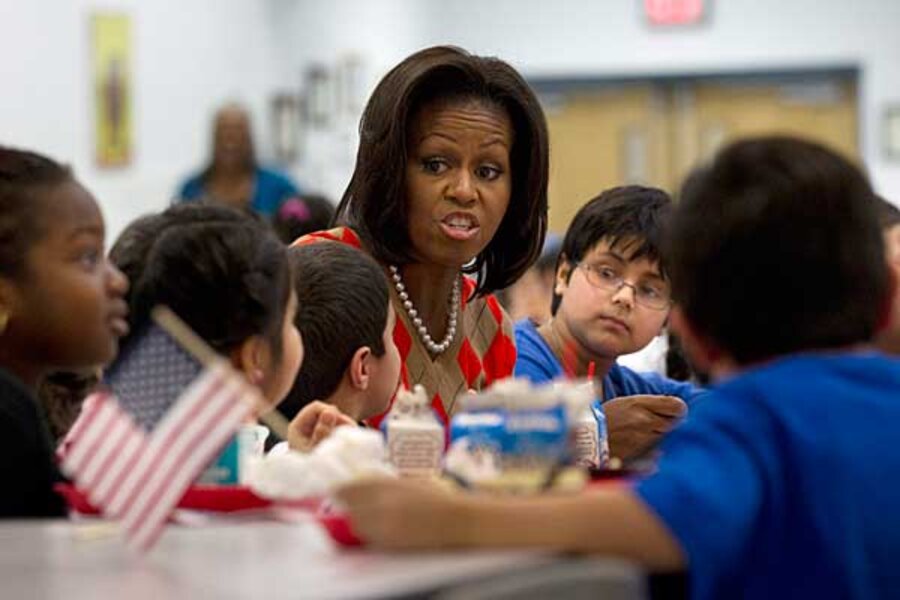School lunches get first overhaul in 15 years – but pizza still a vegetable
Loading...
School lunches are about to get a major overhaul.
Kids can expect more fruits and vegetables, less fat and salt, and more whole grains than in the past.
The new school-meal standards announced by the US Department of Agriculture Wednesday are the first changes to the standards in more than 15 years, and are a major component of the Healthy Hunger Free Kids Act passed last year.
“They’re very good, and they will improve school-lunch programs that affect the diet of over 32 million kids a day,” says Margo Wootan, director of nutrition at the Center for Science in the Public Interest. “They’re really important given the high rates of obesity, kids’ general poor diets, and the state of lunches in most schools.”
The new guidelines include rules for the first time around the amount of sodium, trans fat, and whole grains in school meals, and they set new calorie guidelines based on age, in an effort to limit portion size.
Some staples of the lunch line remain in place: Pizza is still a vegetable, as are French fries, and chocolate milk will still be served.
But pizza can no longer be the only “vegetable” on the plate, the crust will be whole grain, and the chocolate milk will be nonfat.
In a sample before/after menu the USDA provided to illustrate the changes, the whole-wheat pizza would now be served with grape tomatoes, baked sweet potato fries, and apple sauce, compared with the pizza, tater tots, and canned pineapple that might have been offered before.
Another new meal might consist of whole wheat spaghetti and meat sauce, a whole wheat roll, broccoli, cauliflower, green beans, kiwi, and low-fat ranch dipping sauce.
"We have a right to expect that the food they get at school is the same kind of food that we want to serve at our own kitchen tables," said first lady Michelle Obama, a major proponent of the changes, in remarks Wednesday at Parklawn Elementary School in Alexandria, Va.
School meals will now offer twice as many fruits and vegetables and a greater variety, and eventually, all the grains will need to be whole grain. Only low-fat and skim milk will be offered.
“On balance, it’s very positive,” says Tracy Fox, president of Food, Nutrition, and Policy Consultants in Washington.
Still, the final guidelines differ somewhat from what the USDA originally proposed. Congress nixed provisions that would have limited starchy vegetables or removed pizza as a vegetable.
“It’s not ideal given that pizza and French fries are two of the biggest problems in the school lunch program,” says Ms. Wootan. “The biggest weaknesses are the ones where Congress interfered.”
But on the whole, Wootan and other child-nutrition advocates are pleased, and say that the standards represent a big step forward, given many that American children get between one-third and one-half of their calories at school.
The standards are expected to cost $3.2 billion over the next five years, and will be implemented gradually, starting in the next school year. The Healthy Hunger Free Kids Act also includes additional federal funding of 6 cents per meal, training and technical assistance to help schools implement the changes, and new guidelines for foods sold in vending machines and other school venues (expected to be released later this year).
Implementation will be the biggest challenge to making the guidelines effective, says Wootan, saying that she hopes the new policies to support schools – which weren’t in place before – will help schools do a better job than they’ve done in the past.
“Asking schools to do better in how they feed kids is not a new responsibility,” says Wootan. “It’s just saying that if you’re going to feed kids, you should do it in a way that promotes their health instead of undermining it.”





